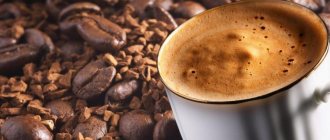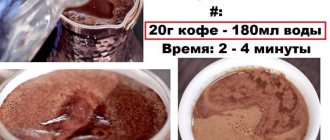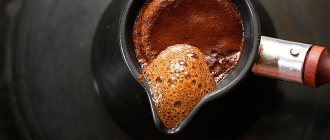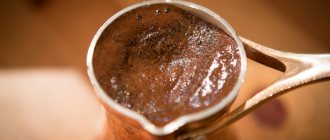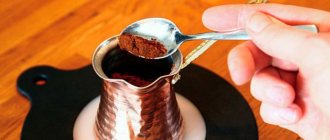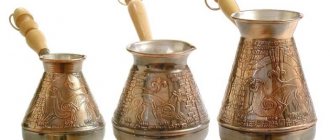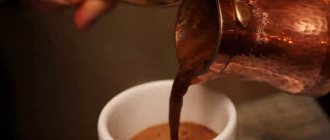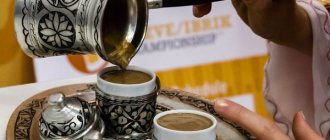Coffee selection
First of all, you need to choose the right coffee. A mixture of two varieties is considered optimal: Arabica and Robusta in an approximate ratio of 75:25. This is done in order, on the one hand, to give the drink a refined aroma (Arabica), and on the other hand, to make its body quite dense (Robusta). The higher the density, the more pronounced the quality of the foam. Preference should be given to well-roasted grains. From practice, packaged bean coffee from Italian producers best meets these requirements.
Turkish choice
The choice of Turks for brewing coffee is of considerable importance. Professionals prefer to deal with unsoldered copper vessels, arguing that this material, due to the presence of a strong oxide film on the surface, will not in any way change the taste and aroma of the prepared product. In addition, the heat capacity of copper is higher than that of other cookware metals. Heat distribution in such a container will occur more evenly. The thicker the wall, the better. In our case, this is important, but we will dwell on this later.
How to brew Turkish coffee with foam
The process of brewing coffee begins with heating the Turk over low heat to a temperature of approximately 120 degrees.
It’s easy to catch this moment if you leave a few drops of water in it. The water has evaporated - the Turk has warmed up enough. Now pour the prepared coffee powder into it and heat it again for 20-30 seconds over low heat, periodically shaking slightly until a pronounced aroma appears (but not burnt). This technique creates the prerequisites for a more complete saturation of the drink with caffeine. One and a half to two teaspoons are needed for one serving. The use of sugar during cooking is guaranteed to increase the density of the foam and its volume. In principle, you can do without using sugar. However, we will further consider the option of using it.
Add granulated sugar in approximately the same amount as coffee. Stir until a homogeneous mixture is obtained and again heat the pot and contents for 30 seconds. Now it’s time to fill it with unboiled cold water (from the tap). The presence of a small amount of salt in such water has a positive effect on the volume of foam. Leave an empty space of one and a half to two centimeters to the edge of the Turk, mix thoroughly in a cold state until the sugar is completely dissolved.
Brew the coffee over very low heat, carefully observing the formation of foam. Using a copper vessel allows for “volume” boiling. This technique ensures the most complete caffeine extraction and uniformity of the drink. When the foam has risen to the edges of the Turk, remove the coffee from the heat, let it stand for 30-40 seconds to settle the relatively large particles of coffee and pour it into the prepared cups in a thin stream, achieving even distribution of the foam. We do not allow a thin layer of sediment from the bottom of the Turk to get into the cups.
To turn coffee making into a ritual, it’s easy to come up with the appropriate surroundings. For example, before starting to warm up, Turks let a younger family member breathe into it, arguing that this will give the drink a special charm. Second option: before starting to make coffee, wash the Turk with a “special solution” (ordinary water). Such small jokes, coupled with the high quality of the drink, will make it special; in less than six months, your coffee will become a signature coffee, and they will call it by your last name.
It is better to serve coffee at the end of dessert, accompanied by a glass of cold still water. This also makes sense because coffee is a fairly strong dehydrator. Adding any flavoring additives or alcoholic beverages to the masterpiece you just created is inadvisable. A glass of good cognac will add significantly more positive impressions after coffee.
It is not advisable to drink coffee with foam, brewed in a Turk, with lemon, milk and other products that “kill” the foam, turning the rather complex process of preparing it into a pointless exercise. In some countries, coffee precedes meals.
We prepare everything you need for foamy coffee
Coffee beans should be ground immediately before preparation.
To brew coffee with foam in a Turk at home, you will need the following:
- Turk;
- Ground coffee (the drink will be much tastier if you grind the beans at home immediately before the brewing process);
- Water (clean drinking water). Spring or well water is best, but bottled water can also be used.
Some people add cane or regular sugar to the drink, but real connoisseurs believe that with the addition of sugar, coffee does not fully reveal its aroma and taste. Fans of spicy taste will love the drink with cinnamon, cloves and other spices.
What coffee to buy
Coffee beans contain essential oils, which, together with oxygen bubbles, form foam on the surface. If a high-quality ground product is used, the foam will be more aromatic and thick. Experts advise grinding the grains before brewing the drink. There are two types of beans: Arabica and Robusta. Arabica is considered an elite species, distinguished by its exquisite taste and unique aroma. Robusta makes the drink very strong.
To ensure that coffee brewed in a Turk on the stove has a thick foam, you should brew it with a fine grind.
Which Turk to choose
Choosing the right Turks is very important. It is believed that the best material for making Turks is copper. A copper pot retains heat inside for a long time. While a foreign smell may appear in a clay pot, this cannot happen in a copper product.
As for the shape, the Turk should have a narrowed neck. This is explained by the fact that all aromatic substances do not evaporate from the surface. Another argument in favor of a narrow neck is that the foam cap will not have time to escape, even if the Turk is mistakenly placed on the highest heat.
Turks made of copper are considered the highest quality
Turkish coffee on the sand
The technology for making Turkish coffee on sand is very similar to that described above. The fundamental difference is that additional equipment is needed: an electric or regular grill and an amount of fine quartz sand corresponding to its volume. Usually they use portioned (small) Turks. The Turks are placed in pre-hot sand so that they are as deep as possible into it. Periodically, the Turks move in the sand to maintain a stable temperature. The drink boils much faster than in the first case, so the taste of the same original coffee will be different. Turks must be metal (preferably copper).
Drink recipe
Many people simply don’t know how to brew Turkish coffee with foam, so they don’t even try, but run to the nearest cafe. But in vain. You may not be able to make a tasty drink the first time, but once you get the hang of it, you will understand how much pleasure this process brings. For those who don't know how to brew coffee in a Turkish oven on the stove, here's the recipe.
You will need:
- Turk.
- Ground coffee – 2 teaspoons. You can buy beans and grind them yourself in a coffee grinder. This will make the aroma even richer and fresher.
- Drinking water – 100 ml.
- Spices to taste, such as sugar or cinnamon.
Now let's find out how to make coffee with foam:
- First, heat the Turk a little, but not too much, otherwise you will ruin the dish itself.
- Pour cold drinking water into the Turk.
- Add natural ground coffee beans and mix gently.
- Place the Turk on low heat.
- During cooking, foam should appear; as soon as it rises, remove from heat.
- Then, when the coffee has stood for a while, you need to put it back on the fire and repeat the process.
- Carefully remove the foam and transfer it to a coffee cup, then slowly pour the coffee down the side. If you want more foam, then remove it constantly, but not completely. Since the foam does not allow the aroma of coffee to evaporate during the brewing process. Your coffee with delicious foam is ready!
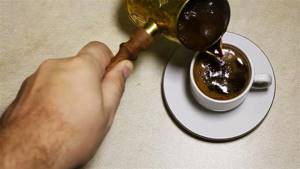
Coffee in a ceramic (clay) Turk: how to brew
One of the innovations used in making coffee is ceramic Turks.
They are made from clay and undergo a long heat treatment process called firing. As a result, the surface of the vessel is covered with a very dense film, reminiscent of sintered glass. Unlike copper, the thermal conductivity of ceramics is significantly less important, which causes differences in the preparation of coffee in it. A ceramic pot takes much longer to heat up and cool down. Therefore, it is necessary to make appropriate adjustments to the technology for preparing the drink in a copper pot, described above. Under no circumstances should the foam reach the edge when boiling, otherwise all the foam will end up on the stove. Experts say that the taste of coffee brewed in this way is ideal, devoid of any foreign odors.
Ceramic Turk is not afraid of high temperatures. Be prepared for the fact that purchasing it will cost you twice or three times as much. Its main drawback is fragility. Therefore, shock loads should be avoided.
Which Turk should you choose?
Despite such a huge variety of coffee machines and coffee makers, the Turk is an integral part in preparing high-quality and tasty coffee with or without foam. The taste and aroma of the drink depends on the choice of Turks. It is made from a variety of materials. The cheapest and most practical is aluminum. True, you cannot mix different types of grains in such dishes. The most popular material is considered to be copper turk. But it must be coated on the inside with food-grade tin to prevent copper from getting into the drink. There are also clay and ceramic Turks. They retain aroma perfectly, but are fragile and short-lived.
The handle of the grater should be wooden, which will prevent you from getting burned. The neck should be narrow and the bottom should be wide, so you can enjoy all the aromas and amazing taste of natural Turkish coffee with foam. Do not choose a large Turk, for a maximum of two cups.

Coffee in a geyser Turk
The use of a geyser turk is fundamentally different from everything stated above. A coffee geyser consists of two metal vessels: the lower one is used to fill in water, the upper one is used to store brewed coffee. The vessels are connected to each other. The connection between them is carried out through a valve, which is activated when the pressure in the lower container increases when water boils. The steam passes through a strainer with pre-filled ground coffee, is saturated with its taste and smell, and then condenses in the upper vessel. This technology is used in an improved form when preparing espresso coffee.
In this case, medium or even coarse grind coffee is used. The amount of it poured into the strainer depends on how many servings you need to get. However, you can’t count on getting decent foam. It is easy to determine the moment of completion of coffee brewing by the characteristic “gurgling” sound.
Above are four options for preparing the miracle drink called “coffee”. Each of them has its supporters and opponents, and debates about whose coffee is better brewed do not subside. Try, experiment, find your unique version, share it with friends.
Cezve: the right material is the main condition for obtaining foam
Coffee prepared in a special cezve is no longer just a drink. It turns from ordinary into exquisite, capable of captivating with its aroma and forever making you fall in love with its taste and aftertaste.
In the distant past, concubines, sultans, kings and emperors in different parts of the world pampered themselves with coffee brewed in a cezve. Poems and poems were written about this drink, it inspired the geniuses of yesteryear, and continues to evoke a storm of emotions among modern gourmets.
So, cezva is the same Turk. It happens:
- ceramic;
- clay;
- metal.
You can brew coffee in a Turk with foam from any material, but the most reliable is copper. It is the copper cezve that is the most durable and suitable for preparing an aromatic and tasty drink at home. Copper heats up well and does not cool down for a long time, maintaining the temperature of the contents. High-quality copper pot - with environmentally friendly coating inside.
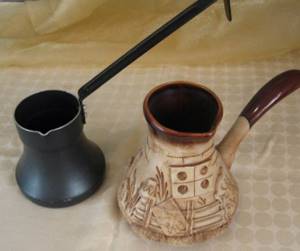
A clay pot is a great environmentally friendly option. The downside of the product is the specific taste with which the clay imbues the drink. However, it’s all about choosing the cezve manufacturer. If this product is made of Chinese Yixing clay, then foreign odors will not be absorbed into the coffee, since the material allows air to pass through, enriching the liquid with it, allowing the bouquet of taste and aroma to fully reveal itself.
You can only cook coffee in a clay pot at home, not forgetting the property of the material to absorb odors.
A universal option is a ceramic Turk. Of all three, it is the most fragile and can become unusable even with a sharp change in temperature. Compared to metal and clay cezves, ceramic is the most expensive and requires special care. But everyone can make coffee with foam in such a Turk the first time, and this is a significant advantage.
You might be interested in Coffee with prunes
